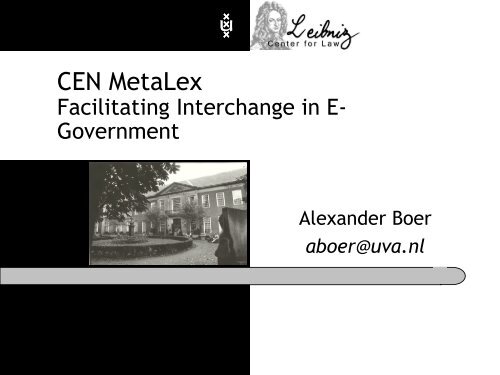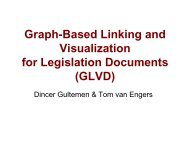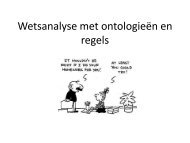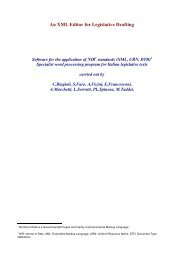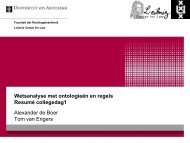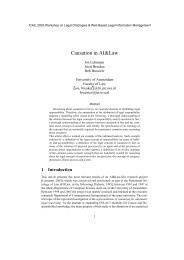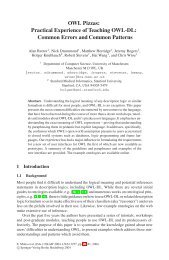Acts - Leibniz Center for Law
Acts - Leibniz Center for Law
Acts - Leibniz Center for Law
- No tags were found...
You also want an ePaper? Increase the reach of your titles
YUMPU automatically turns print PDFs into web optimized ePapers that Google loves.
CEN MetaLexFacilitating Interchange in E-GovernmentAlexander Boeraboer@uva.nl
MetaLex• Initiative taken by us in 2002• Workshop on an open XML interchange<strong>for</strong>mat <strong>for</strong> legal and legislative resources• www.metalex.eu• www.cen.eu• Common document <strong>for</strong>mat, metadata set,ontology, naming convention, andprocessing model <strong>for</strong> documents andmetadata• CEN/ISSS publicly available specification(2006 & 2010)
Problem context• Bibliographic in<strong>for</strong>mation about legislationhas to meet very specific & peculiarrequirements• Jurisdiction-specific & producer-initiatedXML standardization• User organizations & software developersincreasingly deal with legislation fromvarious publishers & jurisdictions• No standardized view on legislation meansno specialized legal software
Current uses of MetaLex• Norme in rete (Italy) implements it• Akoma Ntoso (Pan-African ParliamentaryIn<strong>for</strong>mation) implements it• Single legislation service (UK) is acompatible metadata delivery framework• European Parliament will use it internally(AT4LEX)• doc.metalex.eu makes Netherlands corpusavailable as generic MetaLex (showcase)• Various authoring tools and CMS support it
What does using MetaLex mean?• XML standards that extend MetaLex XMLschema & con<strong>for</strong>m to MetaLex specification• XML standard trans<strong>for</strong>mation con<strong>for</strong>mance• Metadata standards extending MetaLexmetadata• For tools:• MetaLex aware metadata processing & citationdereferencing• Importing generic MetaLex XML or animplementation of it
Lessons learned: important concepts in MetaLex• Content models• Bibliographic identity• Naming conventions• Legislative events and actions• Linked open data
Content models• MetaLex schema defines generic contentmodels and generic elements• Content models are purely syntactic<strong>for</strong>mulations: only the structure ofcontained matter should determinecontent model• E.g. containers, blocks, inlines, milestones,metadata carriers & arbitrary quotedstructures• MetaLex schema con<strong>for</strong>mance usuallyrequires no changes to XML structures
Naming conventions• Adherence to an IRI reference-based, open,persistent, meaningful, memorizable and“guessable” naming convention based onprovenance in<strong>for</strong>mation• Provenance in<strong>for</strong>mation is either encodedinto the IRI, or associated to it as a set ofkey-value pairs (metadata)• E.g. PURL, relative URI, URN, OpenURL• E.g. /ukpga/1985/67/2003-04-01
Bibliographic identity• The naming convention must reliablydistinguish (FRBR) works, expressions,manifestations, and items• sets and subsets of key-value pairs• In law, original expressions are temporalconsolidations, language variants, andauthorized translations• In law, retroactive corrections andannulments of modifications lead to extunc consolidations (two differentbranches)
Stratification of bibliographic entities
Why works, expressions, manifestations, items?• Knowledge representation is aboutexpressions• Legal citation is usually to works,sometimes expressions• Inclusion of expression or manifestation oritem is a different thing• Editing takes place on manifestations• HTTP dereferencing is of items• Metadata confusion• E.g. all have been created at some date
Simple bibliographic identity example• /ukpga/1985/67 is a work• /ukpga/1985/67/2003-04-01 is anexpression• /ukpga/1985/67/2003-04-01.pdf is amanifestation• http://www.metalex.eu/example/ukpga/1985/67/2003-04-01.pdf is an item• http://www.metalex.eu/example/ukpga/1985/67/2003-04-01.rdf is also an item
MetaLex compliant naming conventions• Names are used <strong>for</strong>• Document self-identification• Citation of other documents• Inclusion of document components• Name is either <strong>for</strong>matted as an• Internationalized Resource Identifier (IRI)reference, or• As a set of subject-predicate-object triples‣ A GRDDL translator extracts name RDFmetadata triples and constructs a name IRIreference <strong>for</strong> each name encountered in thesource
MetaLex compliant naming conventions• GRDDL translator requirement:1. N(i) is a name set of triples about opaque IRI i2. n is the naming IRI reference that encodes thesame name as N(i)3. From n construct N(n)4. From N(i) construct n5. En<strong>for</strong>ce that N is equivalent to {n}• Hence if N(i) then i = n etc.• Use OWL2 <strong>for</strong> the purpose‣ {n} is a so-called nominal concept
Constraint en<strong>for</strong>cement (in OWL2)
Common con<strong>for</strong>mance issues in IRI names• The name of a work, expression, ormanifestation is a proper subset of the name ofanother entity within the same ontologicallevel;• The name of an item is equal to that of amanifestation, or the manifestation claims toidentify itself as an item;• The name of a manifestation is equal to that of anexpression or does a bad job of uniquelyidentifying the manifestation among othermanifestations of that expression;• The name of the work and the initial expressionare the same.
Fragment identification
Event descriptions• Organize metadata about legal documentsaround events and acts• Events: interesting changes• <strong>Acts</strong>: events intentionally brought about byagents.• This makes sense from both the point ofview of• knowledge representation tactics, and• legal theory.
Argument from Legal Theory• Institution/constitutiveness interpretation oflegislation (or contracts, or driver’s licenses, taxstatement <strong>for</strong>ms:• One undertakes a legal act on the institutionallevel by producing a written statement inaccordance with a certain procedure.• The document is the physical residue of theintentional act: it functions as physical evidencethat a legislative act that modified institutionalreality happened, and• it declares the intent of that act.• An “Act of Parliament” is the physical result ofthat act of Parliament.
Argument from Knowledge Representation Tactics• A particular metadata description is usuallyabout a snapshot of some entity taken in aparticular state perceived stasis of theentity over a time interval that does nottake account of changes that are outsidethe domain of interest.• The granularity of that snapshot variesacross metadata vocabularies, dependingon the targeted community.
Argument from Knowledge Representation Tactics• To a community that works with certainlegislation daily, the insertion of a new provisionis <strong>for</strong> instance an important event to be noted,and even to prepare <strong>for</strong>;• For the casual reader it just happens to be one ofthe many constituting parts of that document atthe moment of consulting, a casual confrontationwith its current state.• The more you know of something, the moreinteresting events you take note of…
Argument from Knowledge Representation Tactics• For establishing semantic interoperabilitybetween metadata vocabularies exploit thefact that people, organizations, places,dates, events, etc., exist in all domains.• the event/act plays the mediating rolebetween these entities and the resourcethe metadata description is about.
Argument from Knowledge Representation Tactics• E.g. author, publication date, and publicationchannel in<strong>for</strong>mation are participants in thepublication (promulgation) event.• Coherence between the old consolidation, thenew consolidation, the modifying legislation, themodifying authority, and the modification date.• Modification date is• Date of enactment of modifying source• End date of old consolidated version• Start date of new consolidation version
Argument from Knowledge Representation Tactics• Unnecessary duplication• More opportunities <strong>for</strong> error• Incompatible descriptions (perspectives)?• Unnecessary maintenance• events as a conceptual coat rack <strong>for</strong>missing in<strong>for</strong>mation that is <strong>for</strong> preparation<strong>for</strong> future legislation.• Date of enactment of draft versions isunknown, but ordering time constraints isessential <strong>for</strong> simulation
Events in doc.metalex.eu
Linked open dataRecommended (W3C) best practice <strong>for</strong>exposing, sharing, and connectingpieces of data, in<strong>for</strong>mation, andknowledge on the Semantic Webusing URIs and RDF.
Linked open data
MetaLex as linked open data• Storing signed printouts of legislation in asafe syntactic criterium <strong>for</strong> authenticity• Only specification + authenticmanifestation required to know theexpression?• Linked open data depends on theavailability of Internet infrastructure <strong>for</strong>dereferencing and logical inference• Authentic manifestation as envelope <strong>for</strong> allrelevant metadata?
Doc.metalex.eu
Lessons learned: important concepts in MetaLex• Content models• Bibliographic identity• Naming conventions• Legislative events and actions• Linked open data


